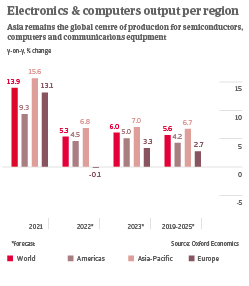Atradius Atrium
Get direct access to your policy information, credit limit application tools and insights.
 New Zealand
New Zealand



High-tech expansion. ICT electronics is an innovative and technology-driven industry. In particular, the semiconductor segment is highly value-added -- and provides robust margins for manufacturers. Expanding semiconductor production is a strategic target in both the US and the EU. US Congress recently passed a “Chips Act” worth USD 52 billion in order to prop up domestic leading edge semiconductor production. In February 2020, the EU Commission announced it will invest a total of EUR 45 billion in chip-related R&D, infrastructure and production until 2030.